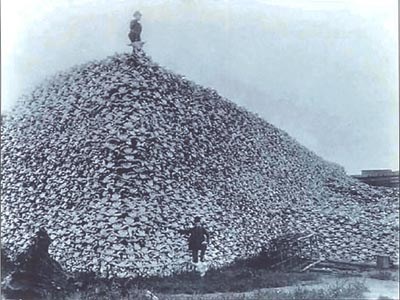Last updated: November 6, 2017
Article
Bison Bellows: From catastrophe to conservation

NPS Photo.
Imagine wandering the streets of greater New York City with your family and friends and the other 20 million people who live there. Now fast forward 20 years and imagine that you are still wandering the streets but everyone has vanished except a mere 1,000 individuals. This type of scene is something you could perhaps imagine in an apocalyptic or dystopian future. The American bison actually experienced this reality when the species' numbers fell from approximately 40 million to less than 1,000 individuals by the beginning of the 20th century. In simple words this was a massive catastrophe.
What does catastrophe mean? The Merriam-Webster dictionary says a catastrophe is a terrible disaster; a final event of a dramatic tragedy; or a momentous event ranging from extreme misfortune to utter overthrow or ruin. In simple math, the decline of 40 million bison over 40 years to less than 1,000 individuals would require on average a bison death every 30 seconds non-stop for four decades.
Beginning at Yellowstone National Park in 1872, the U.S. Department of Interior (DOI) helped lead the way to turn away from complete catastrophe, working with partners to have now restored approximately 10,000 conservation bison onto National Park Service, U.S. Fish and Wildlife Service, and Bureau of Land Management lands. These DOI bison now represent 50% of all known publically protected conservation bison in North America. Still, at the rate of catastrophe described above, these DOI conservation bison equate to replacing only four days of 19th century mortality.
So you may be asking, what does this all mean? We can imagine, but it's extremely hard to grasp the full magnitude of the catastrophe, the long road away from the precipice of extinction, and potential futures for bison conservation. The story of the future of the largest land mammal in North America is yet unwritten. We look forward to this journey of exploration, contemplation, and reaffirmation with you!
Did you know?
Buffalo is a commonly used name for the American bison (Bison bison), though it is actually the name of the true African buffalo (Syncerus caffer) or Asian water buffalo (Bubalus arnee). Historically, many name versions have been used including bisonte, buffes, buffelo, and buffles, and tribal names may vary considerably, with the Sioux "tatanka" having received recent widespread reference and usage through popular media. The common name is now interchanged freely between buffalo and bison without any apparent conflict in meaning or understanding towards effective stewardship. Indeed, there seems little widespread interest or need to adopt either as a single common name and, as such, it appears that the continuing synonymous interchange from the 19th century to present has now become the entrenched preference that integrates prevailing societal agility with a cultural penchant for nostalgia.
